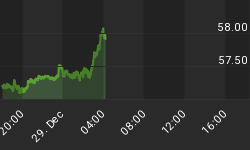One heuristic approach when solving complex problems involves working backwards. But what about flipping things completely over? Well, it turns out that a 100-percent contrarian approach to investing in the U.S. stock market is actually the smarter idea. The most popular stock market benchmark, the S&P 500 Index (SPX), is a float-adjusted market-cap-weighted index, which means companies with bigger market capitalizations are better represented than their smaller brethren.
Investing in the SPX creates exposure to the biggest companies, though not necessarily the best performers. A newer ETF turns this idea on its head by employing a reverse-weight strategy that places greater emphasis on the bottom of the large-cap market.
This reverse strategy has actually been outperforming the traditional approach by quite some margin--over the past 10 years, the Reverse Cap Weighted U.S. Large Cap Index (RVRS) has outpaced the S&P 500 with annualized trailing returns of 17.2 percent vs. 13.1 percent.
In more recent timeframes, RVRS has racked up year-to-date gains of 20.3 percent vs. 19.5 percent for the S&P 500. The difference is not as big but is still significant.

(Click to enlarge)
Source: CNN Money
High-risk tech stocks
Granted, the well-worn playbook of investing in tech and popular FAANG stocks has continued to pay off big time, with the tech heavy Nasdaq Composite Index (COMP) yielding 23.8 percent in the year-to-date, while Technology Select Sector Fund (XLK) sports an impressive 30.4 percent return.
Related: Bezos’ Next Big Project Could Be Worth $100 Billion Per Year
Popular FANG stocks have been impressive--Facebook, Inc. (NASDAQFB) +54.4 percent; Amazon, Inc.(NASDAQ:AMZN) +33.1 percent, Apple, Inc.(NASDAQ:AAPL) +29.5 percent, Netflix, Inc. (NASDAQ:NFLX) +35.7 percent, while Google’s parent company, Alphabet, Inc. (NASDAQ:GOOG) has rallied 10.8 percent.
Yet, these stocks have been soaring largely on expectations that the Fed will lower interest rates sooner rather than later.
That’s not a very sound strategy because high-risk stakes tend to be the most vulnerable in a selloff especially if things do not turn out as expected. Last month’s job report came in much stronger than expected thus lowering the odds of a rate cut.
Phi Bak, CEO of investment firm Exponential ETFs, told CNN Business that investors have been taking on too much risk by betting the farm on tech stocks and ignoring value stocks.
One way to mitigate the risk is by taking a contrarian approach and investing in a fund like RVRS that has proved that there’s money to be made outside a handful of top tech firms. Some of its major benefits include:
- Tilts large-cap exposure to the lower end of the spectrum. Over the past decade, smaller caps have outperformed larger ones with the S&P Small-Cap 600 yielding 100 basis points higher than the S&P 500
- Distribution of stock weightings is less concentrated thus increasing overall diversification
- The weighted average market cap that is significantly lower than the S&P 500’s yet significantly higher than mid cap funds
- Low expense ratio of 0.29 percent
Another angle would be to invest in a fund like the American Customer Satisfaction ETF (ACSI).
The ETF is made up of companies that American consumers love. Incidentally, its top holdings include FANG stocks Apple , Amazon and Netflix but also well-known ones such as Hershey Corp. (NYSE:HSY), Alaska Air Group Inc. (NYSE:ALK), Vonage Holdings Corp. (NYSE:VG), Clorox Co (NYSE:CLX), Keurig Dr Pepper Inc. (NYSE:KDP) and MetLife, Inc. (NYSE:MET). ACSI has managed to keep pace with the market with a 19.4 percent YTD gain.
For investors interested in the reverse strategy, Bak advises that mixing the two funds helps smooth out volatility by massively improving diversification from an HHI ( a measure of diversification) reading of 89 to just 33.
By Alex Kimani for SafeHaven.com
More Top Reads From Safehaven.com:

















